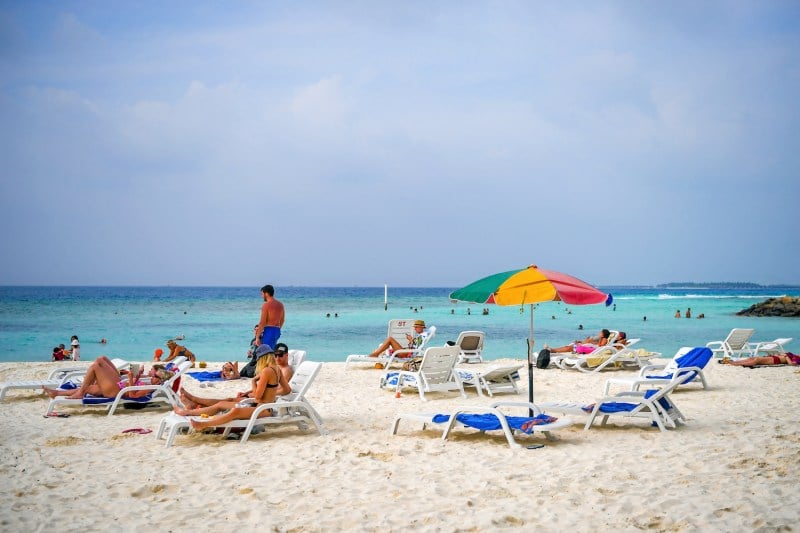U.S. Eyes Pakistan’s Mineral Wealth

U.S. Eyes Pakistan’s Mineral Wealth
But investment in tapping the country’s reserves would be a dangerous gamble.
Workers drill a hole to extract salt in the Khewra mine in Jhelum, Pakistan, on Dec. 12, 2023. Elke Scholiers/Getty Images
Welcome to Foreign Policy’s South Asia Brief.
The highlights this week: U.S. officials express interest in Pakistan’s mineral reserves, the United States extradites a suspect in the 2008 Mumbai attacks to India, and reporting reveals that U.S.-made weapons have fallen into the hands of Pakistani militants.
Welcome to Foreign Policy’s South Asia Brief.
The highlights this week: U.S. officials express interest in Pakistan’s mineral reserves, the United States extradites a suspect in the 2008 Mumbai attacks to India, and reporting reveals that U.S.-made weapons have fallen into the hands of Pakistani militants.
Pakistan’s Minerals Moonshot
Eric Meyer, the senior official in the U.S. State Department’s Bureau of South and Central Asian Affairs, led a delegation to Islamabad last week to attend a minerals investment forum. In a meeting with Pakistani Prime Minister Shehbaz Sharif, Meyer said U.S. companies were keen to invest in the country’s untapped mineral reserves.
This could reflect a broader interest on the part of U.S. President Donald Trump’s team. The discussion came two days after U.S. Secretary of State Marco Rubio signaled prospects for Washington to cooperate with Islamabad on critical minerals during a call with Pakistani Foreign Minister Ishaq Dar.
This interest seems to extend to the U.S. Congress, too. Rep. Jack Bergman, the co-chair of the Congressional Pakistan Caucus, recently identified minerals as a “key sector” for partnership. Bergman traveled to Islamabad last weekend as part of the first congressional delegation to Pakistan since 2023.
Pakistan’s mineral reserves, which include massive copper and gold deposits as well as critical minerals such as lithium, are estimated to stretch across more than 230,000 square miles—more than twice the size of the United Kingdom.
Islamabad has long trumpeted its mineral wealth, which it currently estimates at $8 trillion, but it has also long struggled to find willing investors. This makes the Trump administration’s interest significant. However, the prospects for U.S.-Pakistan minerals cooperation shouldn’t be overstated; serious security risks make such partnership a dangerous gamble.
Minerals might appear to be a new sweet spot for a relationship that has struggled to find anchors for partnership since the U.S. withdrawal from Afghanistan in 2021. The Trump administration’s strong interest in critical minerals is well known. China’s recent decision to suspend rare-earth exports gives the United States extra incentive to explore opportunities in Pakistan.
Meanwhile, Pakistan might see an opportunity to showcase its mineral riches to a deeply transactional administration. Sharif also says mineral investments can reduce Pakistan’s dependence on international financing and bolster its long-term economic sustainability.
Security, however, will be a massive challenge. Mining firms often accept high risks, given the volatile terrain in which they operate. But Pakistan’s conditions are especially dangerous for prospective mining investors. The country suffered 521 terrorist attacks last year, according to the Pak Institute for Peace Studies—a 70 percent increase from 2023.
More than 95 percent of the 521 attacks were in the provinces of Balochistan and Khyber Pakhtunkhwa—where, according to official mineral mapping, most of Pakistan’s known mineral deposits are located. This trend has continued in 2025: Of the 54 terrorist attacks reported in Pakistan in February, 53 were in those two provinces.
The separatist Balochistan Liberation Army (BLA) is one of Pakistan’s most potent violent actors. The number of attacks perpetrated by the BLA and other banned Baloch insurgent groups increased by 119 percent between 2023 and 2024.
Broadly, counterterrorism operations, state crackdowns, and large infrastructure projects in Balochistan and Khyber Pakhtunkhwa in recent decades have angered local communities. And significantly, anger about resource exploitation has long fueled BLA attacks.
As a result, mineral investors would be stepping into a powder keg. Pakistan’s army chief has promised to provide security to mineral investors, but Pakistan hasn’t sufficiently addressed the security concerns of investors from China—its closest ally—despite deploying thousands of security forces to protect Chinese infrastructure projects.
If mineral investors from the United States or elsewhere are looking at opportunities in Pakistan, they might push to bring in their own security forces. This is illegal in Pakistan, but if Islamabad gave in, that would create even more volatility.
There are also infrastructure and energy constraints to mineral investment in Pakistan. For example, Sharif has called on investors to refine and process minerals in-country. But executives from Canada-based Barrick Gold, one of the few foreign mining companies currently operating in Pakistan, say there is insufficient cheap and reliable electricity. (Barrick Gold is partnering with Pakistan to develop a gold and copper mine in Balochistan.)
Pakistan has long exemplified what is known as the resource curse, as a country that struggles economically despite massive mineral wealth. Given security risks and other obstacles, it’ll be tough to break anytime soon.
What We’re Following
Mumbai attack suspect extradited to India. Last week, Tahawwur Rana—a suspect in the 2008 Mumbai attacks—was extradited from the United States to India. The terrorist attacks were carried out by the Pakistan-based group Lashkar-e-Taiba (LeT) and killed 166 people across the city in hotels, a hospital, a restaurant, and a Jewish community center.
Rana is a Canadian citizen of Pakistani origin, but he was living in the United States during the attacks. He was initially arrested in the United States in 2009, but various legal issues kept him from being extradited until now. He was serving a 14-year sentence in Los Angeles for providing support to LeT.
Though Indians have applauded the extradition of Rana, many are focused on another U.S.-based co-conspirator of the Mumbai attacks: Pakistani American David Headley, who has confessed to being an LeT member and operative with Pakistan’s main spy agency.
Headley is currently serving a 35-year sentence in the United States for his role in helping to plan the attacks; he signed a plea agreement that stipulated that he not be extradited. But some Indians believe that Washington is protecting him unnecessarily. (The United States has denied allegations that Headley once worked as a U.S. government operative.)
Indian fugitive arrested in Belgium. Meanwhile, Mehul Choksi, a diamond jeweler and one of India’s most prominent fugitives, was arrested by Belgian authorities over the weekend in the city of Antwerp, which is known for its diamond industry.
Choksi is wanted on charges related to a plot to defraud Punjab National Bank (PNB) of nearly $1.8 billion. Choksi headed an Indian jewelry retailer that once oversaw several thousand stores across India. India is seeking his extradition, but Choksi’s lawyer said he will contest the request because of insufficient evidence of guilt as well as Choksi’s poor health.
Choksi is often associated with his nephew Nirav Modi, another high-end diamond merchant who is also accused in the PNB fraud case; he is currently awaiting extradition in London, though, according to Indian reports, a long legal process makes that unlikely for the foreseeable future.
Report reveals Pakistani militants using U.S. weapons. On Monday, a Washington Post investigation revealed that U.S. weapons previously used by Afghan security forces before the Taliban takeover in August 2021 have landed in the hands of Pakistani militants. The weapons include assault rifles, machine guns, and night-vision goggles.
U.S. Army and Defense Department officials confirmed to the Post that at least 63 weapons seized by Pakistani officials from militants had been originally given to Afghan security forces by the U.S. government. The regional implications of these loose weapons may extend beyond Pakistan: Indian officials have said militants in Indian-administered Kashmir also use U.S.-made weapons.
The Post reports that the BLA used U.S.-made rifles when it hijacked a passenger train last month—the first time any group has done so in Pakistan. The investigation effectively validates Pakistani officials’ claims that the Taliban takeover enabled these groups to strengthen their capacities with U.S. weapons.
However, this shouldn’t take away from the other key factors driving increased militancy in Pakistan, which include safe havens in Taliban-led Afghanistan and the lack of a Pakistani strategy to curb terrorism.
Under the Radar
On Tuesday, the Maldives announced that it would ban Israeli nationals from entering the country—a gesture intended to express “resolute solidarity” with Palestinians amid the ongoing conflict in Gaza. The Maldivian economy relies heavily on tourism, but this is a low-risk move: Last year, Israelis made up just 0.6 percent of total tourist arrivals in the country.
The ban could also benefit President Mohamed Muizzu politically: Both government allies and the political opposition have pushed for such a move, which will likely be popular among the public.
Meanwhile, Sri Lanka—another island state with a shaky and tourism-dependent economy—has taken a different approach to Israeli tourists, who are flocking to the country and especially to the resort town of Arugam Bay. There, Israeli tourism has led to tensions with locals, including complaints about cultural insensitivity and increased security measures.
Some Sri Lankans worry that the large number of Israeli military personnel among the tourists could still increase the risk of terrorist attacks. Last year, a U.S. Embassy security alert prompted the evacuation of U.S. and Israeli tourists from Arugam Bay, before being rescinded weeks later.
This all makes for a delicate challenge for Sri Lanka, which maintains friendly relations with Israel. The number of Israeli tourists coming to Sri Lanka doubled last year, to 20,000, suggesting that they can make a difference economically.
FP’s Most Read This Week
- Why Don’t Russian Soldiers Revolt? by Amelie Tolvin
- Why Beijing Thinks It Can Beat Trump by Scott Kennedy
- The Awful History of Tariffs and Depressions by Scott Reynolds Nelson
Regional Voices
In the Express Tribune, Asghar Zaidi, a former university vice chancellor, argues that Pakistan must strengthen its higher education sector. “The need is not for just more universities, but for better ones—future-ready, globally competitive institutions that integrate artificial intelligence (AI), foster inclusion, align with future job markets, and empower students to lead and innovate,” he writes.
A Daily Star editorial examines how Bangladesh’s garment exports-dependent economy can shield itself from risks posed by the U.S.-China trade war. “Diversifying products and markets, forging bilateral and regional trade ties, encouraging foreign investments and joint ventures, and enhancing the country’s brand value must be explored creatively and with urgency,” it argues.
In the Print, journalist Karanjeet Kaur discusses the growing global popularity of urrak, an alcoholic drink made in the Indian state of Goa. “In urrak’s journey from Goan tavernas to Tokyo’s elite bars, a truly local symbol gradually becomes universal—not through mass production, but by remaining exactly what it is and has always been,” she writes.
Michael Kugelman is the writer of Foreign Policy’s weekly South Asia Brief. He is the director of the South Asia Institute at the Wilson Center in Washington. X: @michaelkugelman
More from Foreign Policy
-

U.S. President Donald Trump gives a thumbs-up upon arrival at Joint Base Andrews in Maryland after spending the weekend at Mar-a-Lago. How to Ruin a Country
A step-by-step guide to Donald Trump’s destruction of U.S. foreign policy.
-

Chinese President Xi Jinping arrives for a meeting with Vietnamese National Assembly Chairman Tran Thanh Man in Hanoi on April 14. Why Beijing Is Standing Up to Trump
Chinese leaders have their pride, too.
-

Russian soldiers practice marching Why Don’t Russian Soldiers Revolt?
Astonishing death rates and brutal abuse have not kept troops from following orders.
-

An illustration shows a police officer trying to sudue a panicked mob of men. The Awful History of Tariffs and Depressions
What the 19th century teaches us about what happens next.









Join the Conversation
Commenting on this and other recent articles is just one benefit of a Foreign Policy subscription.
Already a subscriber?
.
Subscribe
Subscribe
View Comments
Join the Conversation
Join the conversation on this and other recent Foreign Policy articles when you subscribe now.
Subscribe
Subscribe
Not your account?
View Comments
Join the Conversation
Please follow our comment guidelines, stay on topic, and be civil, courteous, and respectful of others’ beliefs.
Change your username |
Log out
Change your username:
CANCEL
Confirm your username to get started.
The default username below has been generated using the first name and last initial on your FP subscriber account. Usernames may be updated at any time and must not contain inappropriate or offensive language.